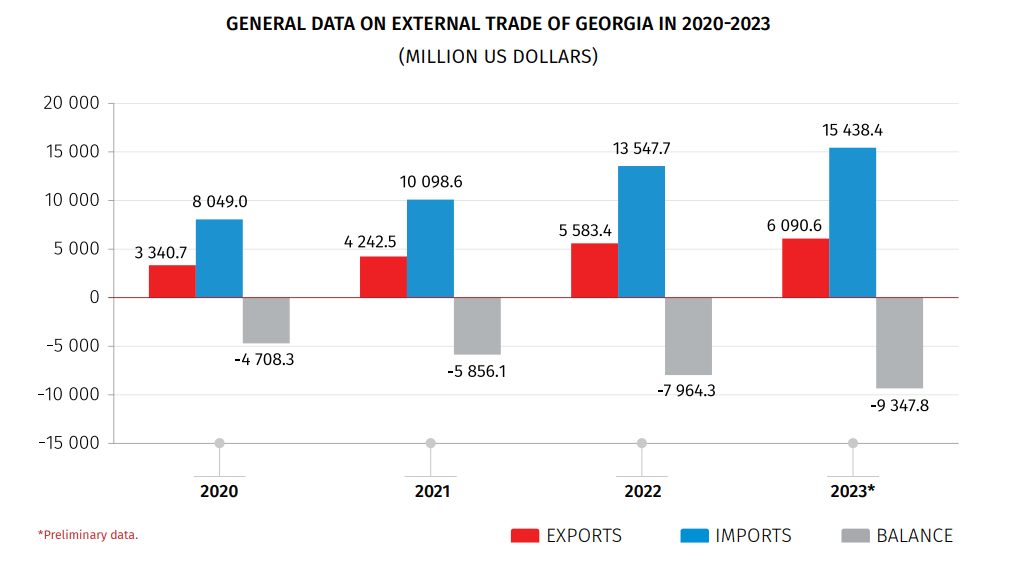Economy of Georgia is one of the fastest-growing ones in the countries of the Caucasus region. Because of extensive economic reforms, foreign direct investments in different fields, and development of infrastructure, Georgia established a notable position in global markets. Key sectors like construction, agriculture, tourism, and financial services started playing a huge role in the development of the Georgian economy, and in this blog we will tell you everything you need to know about the rise of the economy of Georgia.
Overview of Georgia’s Economy
Despite historical challenges and invasions, based on overview of Georgia’s economy, we can say that Georgia has successfully organized its economy. In 2025, Georgia continues to solidify its position as one of the most resilient and reform-driven economies in the South Caucasus due to various contributing factors. After achieving consistent annual growth rates above 5% over the past decade, the country has maintained stability amid global uncertainties. The Georgian economy went through reforms in finances, regulations of tax in Georgia, and business deregulation, and those reforms have strengthened both Georgian and foreign investors’ confidence. Sectors such as tourism, energy, IT, and construction have become key growth engines.
Despite rising pressures in the world economy and currency fluctuations, the Georgian lari remains relatively stable. Georgia’s economic outlook remains optimistic, with reforms that are constantly happening and changing the economy for the better, as well as geopolitical positioning that is fostering a favorable environment for long-term development.
Trade in Georgia
Georgia’s strategic geographic position makes trade a major factor in growth of economy of Georgia. As a bridge between Europe and Asia with access to Black Sea ports, it has become a regional trade hub in exports, imports, and logistics. By 2025, Georgia’s trade sector continues to grow steadily, reflecting its role as a regional gateway between Europe and Asia. In just the first five months of the year, Georgia’s total foreign trade increased by over 13% compared to the same period in 2024. This growth builds on the previous year’s performance, where total external trade volume reached approximately $23.4 billion—a solid 8% year-on-year rise. The country definitely benefits from its strategic location and its open trade policies, but the trade balance remains uneven, with imports significantly outpacing exports.
From January to May 2025, Georgia exported around $2.6 billion worth of goods—up by 15%—while imports climbed to roughly $7.2 billion, an increase of 13%. This widening trade gap, with imports nearly triple the value of exports, leaves Georgia with a substantial trade deficit of more than 45% of its total trade volume. The main destinations for Georgian goods are countries in Central Asia and the Caucasus, such as Kyrgyzstan, Kazakhstan, and Azerbaijan.
On the import side, Georgia sources most of its goods from highly industrialized nations. The United States became Georgia’s top import partner in early 2025, with imports reaching around $1.1 billion, followed closely by Turkey and Russia. These imports mainly include machinery, equipment, and fuel. The government continues to encourage domestic production and export diversification as a long-term strategy to close the trade gap and support economic resilience. Based on these reports, we can say that for people who are thinking about company registration in Georgia, trade will definitely be a profitable subject to invest in.

Export Opportunities in Georgia
Exporting to Georgia presents many opportunities since the market remains underdeveloped with significant growth potential. Thanks to recent reforms, Georgia is now attractive for exporters of food, agricultural goods, machinery, industrial equipment, construction materials, chemicals, and consumer goods. In 2025, Georgia’s export landscape is brimming with opportunity, driven by robust sectors like agriculture, beverages, tech, and light manufacturing. Agro-exports surged 17% in 2024 to a record $1.68 billion, with wine, mineral waters, fruits, and nuts leading the way. Georgia’s emphasis on aligning with EU standards is already paying off, with agricultural exports to the EU up 11% in 2024, indicating growing trust in the quality of Georgian produce. Beyond food and drink, other sectors are gaining export traction. The beverage and fruit industries are expanding into new markets such as Poland, China, and Russia.
The Georgian Lari & Currency Stability
The Georgian currency, the lari (GEL), plays a key role in economic stability and attracting people who are interested in investment in Georgia. After independence from the USSR, the country faced volatility in its currency. But with economic reforms and currency stabilization measures by the central bank, the lari has gradually become more stable. Foreign investments and increased trade have also supported the lari’s value.
USD Exchange Rate
The exchange rate is a crucial economic indicator in Georgia. As of early July 2025, the USD to GEL exchange rate is approximately ₾2.72 for US $1. With the quick overview we can see
- This mid‑year rate has been quite stable—hovering between ₾2.72 and ₾2.74 since June.
- The rate hit a high of about ₾2.88 in late January and a low near ₾2.72 in mid-June.
- Currency shoppers or travelers can expect roughly ₾2.72–2.74 per US dollar when exchanging money.
- Currency stability around the low 2.7 range means less volatility, beneficial for those budgeting in GEL.
If you’re planning transfers, budgeting, or tracking trends, basing your calculations on ₾2.72–2.74 per USD is a reliable guide for now.
 Conclusion
Conclusion
Despite numerous challenges, Georgia has built a path toward sustainable economic growth through reforms and foreign investment. Its strategic location, improved infrastructure, and supportive government policies have contributed significantly to its development. However, challenges remain, including currency volatility, reliance on imports, and vulnerability to global economic trends. Continued reforms, export diversification, and sectoral improvements can further enhance its economic standing and social well-being. Georgia has many opportunities ahead to become a leading economy in the region.








No comment